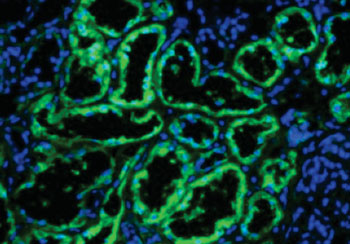Loss of Regulatory Enzyme Spurs Kidney Cancer Growth
By LabMedica International staff writers
Posted on 31 Jul 2014
Cancer researchers have found that the enzyme fructose-1,6-bisphosphatase 1 (FBP1) is missing or inactive in the clear cell renal cell carcinoma (ccRCC) form of kidney cancer, a lack that gives the cancer cells a metabolic advantage over surrounding normal tissue.Posted on 31 Jul 2014
FBP1 is a gluconeogenesis regulatory enzyme that catalyzes the hydrolysis of fructose1,6-bisphosphate to fructose 6-phosphate and inorganic phosphate. Fructose-1,6-diphosphatase deficiency is associated with hypoglycemia and metabolic acidosis.

Image: A metabolic enzyme has an unexpected role in regulating gene expression in kidney cancer. Primary human kidney tissue: FBP1 protein (green); cell nuclei (blue) (Photo courtesy of the University of Pennsylvania).
Investigators at the University of Pennsylvania (Philadelphia, USA) have been working with a mouse ccRCC model. Previous studies had shown that kidney tumors of this type were characterized by elevated glycogen levels and fat deposition. Development of these characteristics was associated with elevated expression of hypoxia inducible factors (HIFs) and mutations in the von Hippel-Lindau (VHL) encoded protein, pVHL, which occurs in 90% of ccRCC tumors.
The VHL protein (pVHL) is involved in the regulation of hypoxia inducible factor 1 alpha (HIF1alpha). This is a subunit of a heterodimeric transcription factor that at normal cellular oxygen levels is highly regulated. Under normal physiological conditions, pVHL recognizes and binds to HIF1alpha only when oxygen is present due to the post translational hydroxylation of two proline residues within the HIF1alpha protein. pVHL is an E3 ligase that ubiquitinates HIF1alpha and causes its degradation by the proteasome. In low oxygen conditions or in cases of VHL disease where the VHL gene is mutated, pVHL does not bind to HIF1alpha. This allows the subunit to dimerize with HIF1beta and activate the transcription of a number of genes, including vascular endothelial growth factor, platelet-derived growth factor B, erythropoietin, and genes involved in glucose uptake and metabolism.
In the current study, which was published in the July 20, 2014, online edition of the journal Nature, the investigators used an integrative approach comprising metabolomic profiling and metabolic gene set analysis to examine more than 600 kidney tumors from human patients. They determined that FBP1 was uniformly depleted in all of the ccRCC tumors examined. The human FBP1 locus was found to reside on chromosome 9q22, the loss of which was associated with poor prognosis for ccRCC patients.
FBP1 was found in the nucleus of normal cells, where it bound to HIF to modulate its effects on tumor growth. In cells lacking FBPI, rapidly growing tumor cells were found to produce energy up to 200 times faster than normal cells.
“This study is the first stop in this line of research for coming up with a personalized approach for people with clear cell renal cell carcinoma-related mutations,” said senior author Dr. Celeste Simon, professor of cell and developmental biology at the University of Pennsylvania. “Since FBP1 activity is also lost in liver cancer, which is quite prevalent, FBP1 depletion may be generally applicable to a number of human cancers.”
Related Links:
University of Pennsylvania














